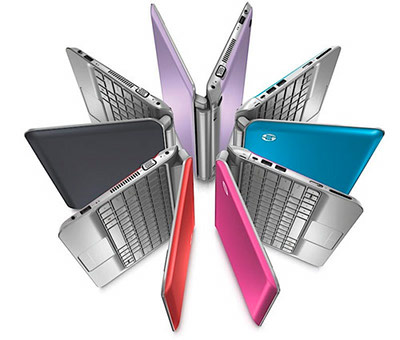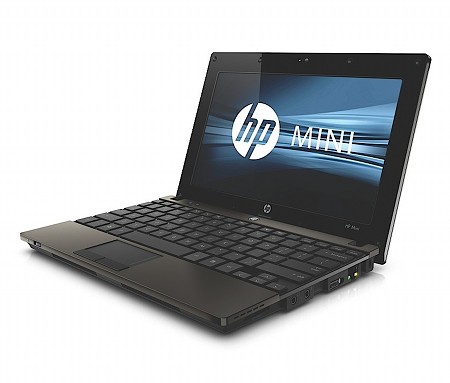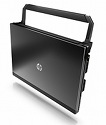HP netbooks get dual-core Atoms
Sep 1, 2010 — by LinuxDevices Staff — from the LinuxDevices Archive — 2 viewsHP has revamped two of its 10.1-inch netbooks to include Intel's recently announced, dual-core Atom N550 processor, along with optional Broadcom video accelerator chips. Both netbooks are available with Windows 7, but the Mini 210 also offers a Linux-based “QuickWeb” fast boot option, and the Mini 5103 is available with a full SUSE Linux installation.
HP's first netbook, the April 2008 Mini-Note 2133, featured a Via C7-M ULV processor, an aluminum shell, and a coated "DuraKeys" keyboard, and was touted as being suitable for business and educational markets. HP later targeted consumers with the Atom N270-based Mini 1000, released in October 2008.
Since then, the manufacturer has released a bevy of additional netbooks, many of them critically well-received, under both its HP and Compaq brands. HP's offerings have all featured similar technology, but each has been tweaked somewhat to suit consumer, enterprise, or educational markets. Such is yet again the case with the new Mini 210 and Mini 5103, both of which offer the dual-core Atom N550 processor Intel announced last month.
Mini 210 (mid-2010 model)
The new Mini 210 (below) is a revamp of an identically named device announced in January. Like the earlier version, it's said to be aimed at the "mobile consumer," but now steps up from the earlier, 1.66GHz Atom N450 to, at a minimum, the DDR3-equipped Atom N455.

Colors for HP's revamped Mini 210
(Click to enlarge)
According to HP, the mid-2010 Mini 210 also gets a six-cell battery that now fits flush with the rest of its case and provides up to 10.75 hours of battery life. Plus, the device is said to be newly available in a choice of five finishes: "charcoal, crimson red, lavender frost, luminous rose, and ocean drive."
Additionally, in what some — well, us, to be precise — may consider product proliferation gone mad, the Mini 210 is offered with a choice of three CPUs. There's the N455 already mentioned, plus the 1.83GHz N475 and the dual-core, 1.5GHz N550, according to HP.
Purchasers of the N475 or N550 versions of the Mini 210 who want an additional speed boost may select an optional Broadcom Crystal HD video accelerator. Thusly equipped, the devices play back 720p and 1080p video from local files or "the most advanced video websites," according to HP.
HP says the Mini 210 comes with 160GB or 250GB hard disk drives, and its 10.1-inch screen is offered with resolutions of either 1024 x 600 or 1366 x 768 pixels. The device runs Windows 7 Starter or Windows 7 Premium, but is also said to include QuickWeb, a quick-booting Linux environment based on DeviceVM's Splashtop technology.
Specifications listed by HP for its revised Mini 210 include the following:
- Processor — 1.66GHz Atom N455, 1.83GHz Atom N475, or 1.5GHz, dual-core, Atom N550
- Chipset — Intel NM10, plus optional Broadcom Crystal HD video accelerator
- Memory — 1GB or 2GB of DDR3 RAM
- Display — 10.1-inch screen with 1024 x 600 or 1366 x 768 resolution
- Camera — webcam (resolution n/s)
- Storage — 160GB or 250GB hard disk drive (7200rpm)
- Expansion — memory card reader (n/s but presumed to be present)
- Networking:
- LAN — 10/100 Ethernet
- WLAN — 802.11b/g/n
- PAN — Bluetooth (optional)
- Other I/O:
- GPS receiver (optional)
- 3 x USB 2.0
- 1 x VGA
- audio I/O (not detailed)
- Battery — six-cell, with up to 10.75 hours of operation
- Dimensions — 10.55 x 7.51 x 1.26 inches
- Weight — 3.1 pounds
Mini 5103
Like the Mini 5102 introduced in January, the SUSE Linux-ready Mini 5103 is designed "for mobile professionals and students," and it's again available with an capacitive multitouch screen. The revised netbook not only gets the same CPU and video accelerator options as the Mini 210, it also enjoys — be still, my beating heart! — a slightly incremented model number.

HP's Mini 5103
(Click to enlarge)
According to HP, the Mini 5103 (above) is available with 10.1-inch screens that come in 1024 x 600 or 1366 x 768 pixel resolutions. Hard disks range in size from 160GB to 320GB, and SSD (solid state disk) options are available with either 80GB or 120GB capacities, the company says.
 HP says Mini 5103 customers can choose either a four-cell battery that keeps weight down, or a six-cell battery that delivers more than ten hours of battery life. Like the Mini 5103 before it, the device is offered with the optional carrying handle seen at right.
HP says Mini 5103 customers can choose either a four-cell battery that keeps weight down, or a six-cell battery that delivers more than ten hours of battery life. Like the Mini 5103 before it, the device is offered with the optional carrying handle seen at right.
It's said the Mini 5103 sports "DayStarter," a software program that offers "allows users to get a head start on the day's activities through a customized 12-hour calendar display that offers quick access to appointments and battery status." Better yet, DayStarter shows up while the operating system is still booting, says HP.
Operating system choices on this model are in fact said to encompass Windows 7 Home Premium or Windows 7 Home Starter Edition, SUSE Linux Enterprise 11, or FreeDOS. (However, the optional capacitive touchscreen only works with Windows, HP warns.)

HP's USB 2.0 Docking Station
(Click to enlarge)
An accessory touted for the Mini 5103 is the HP USB 2.0 Docking Station (above), which uses "universal USB technology" — licensed from DisplayLink — to "pass through critical signals such as video and LAN and connect with peripherals such as a keyboard, mouse or printer." This accessory would presumably function with the Mini 210 too, or any other USB-equipped portable device, for that matter.
Specifications listed by HP for its Mini 5103 include the following:
- Processor — 1.66GHz Atom N455, 1.83GHz Atom N475, or 1.5GHz, dual-core, Atom N550
- Chipset — Intel NM10, plus optional Broadcom Crystal HD video accelerator
- Memory — 1GB or 2GB of DDR3 RAM
- Display — 10.1-inch screen with 1024 x 600 or 1366 x 768 resolution, plus optional capacitive touchscreen
- Camera — 2.0 megapixel webcam
- Storage — 160GB, 250GB, or 320GB hard disk drives (7200rpm)
- Expansion — SD/MMC slot; PCI Express Mini card slot for broadband module
- Networking:
- LAN — 10/100 Ethernet
- WLAN — 802.11a/b/g/n or 802.11b/g/n
- WWAN — Qualcomm Gobi broadband module supporting both CDMA and UMTS networks (optional; not available when Broadcom video accelerator is installed)
- PAN — Bluetooth 2.0 or 3.0 (optional)
- Other I/O:
- 3 x USB 2.0
- 1 x VGA
- audio — mic in, headphone/line out
- Battery — four-cell or six-cell
- Dimensions — 10.3 x 7.09 x 0.91 inches without touchscreen; 10.3 x 7.09 x 0.98 with touchscreen
- Weight — 2.64 pounds without touchscreen; 2.86 pounds with touchscreen
Further information
According to HP, the Mini 210 and Mini 5103 are available in the U.S. now, with prices starting at $329 and $399, respectively. More information may be found on the company's website here and here, respectively.
This article was originally published on LinuxDevices.com and has been donated to the open source community by QuinStreet Inc. Please visit LinuxToday.com for up-to-date news and articles about Linux and open source.